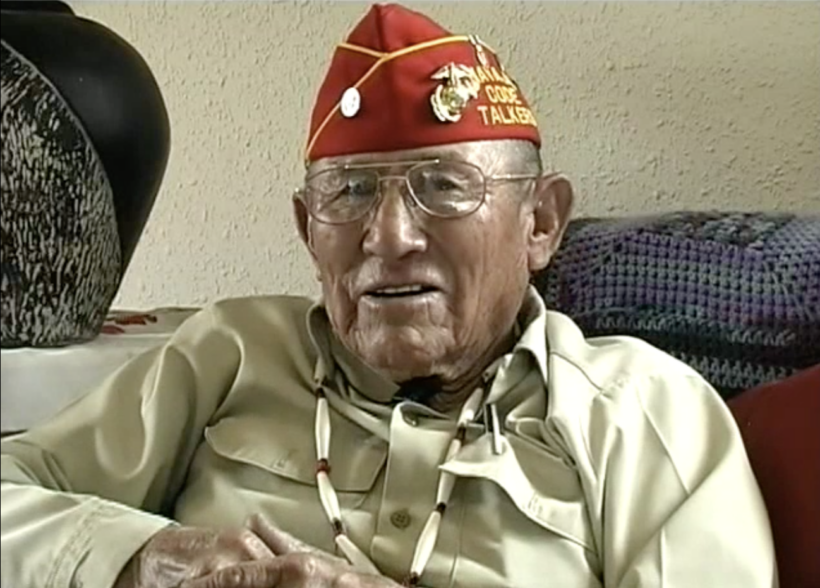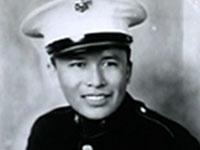
John Kinsel Sr
redo Jump to...
print Print...
 (Associated Press – AP) — John Kinsel Sr., one of the last remaining Navajo Code Talkers who transmitted messages during World War II based on the tribe’s native language, has died. He was 107.
(Associated Press – AP) — John Kinsel Sr., one of the last remaining Navajo Code Talkers who transmitted messages during World War II based on the tribe’s native language, has died. He was 107.
Navajo Nation officials in Window Rock, Arizona announced Kinsel’s death on Saturday.
Tribal President Buu Nygren has ordered all flags on the reservation to be flown at half-staff until Oct. 27 at sunset to honor Kinsel.
“Mr. Kinsel was a Marine who bravely and selflessly fought for all of us in the most terrifying circumstances with the greatest responsibility as a Navajo Code Talker,” Nygren said in a statement Sunday.
“He fought alongside his brothers in arms, for the U.S. Marine Corps, for the United States and to protect the Navajo Nation in a time of war.”
Kinsel’s son, Ronald Kinsel, had informed Nygren that his father died in his sleep early Saturday.
“He lived a very long, full and accomplished life. What he and the other Code Talkers accomplished changed the course of history, and will always be remembered, and I will continue to tell his legend and greatness,” the younger Kinsel said in a statement.
With Kinsel’s death, only two Navajo Code Talkers are still alive: Former Navajo Chairman Peter MacDonald (who is 95) and Thomas H. Begay (98 years old).
Approximately 400 Navajos were recruited by the Marines to serve as Code Talkers during the war, transmitting messages based on their then-unwritten native language.
They confounded Japanese military cryptologists during World War II and participated in all assaults the Marines led in the Pacific from 1942 to 1945, including at Guadalcanal, Tarawa, Peleliu and Iwo Jima. The Japanese were never able to break the code.
The Code Talkers sent thousands of messages without error on Japanese troop movements, battlefield tactics and other communications crucial to the war’s ultimate outcome.
Kinsel was born in Cove, Arizona, and lived in the Navajo community of Lukachukai.
He enlisted in the Marines in 1942 and became an elite Code Talker, serving with the 9th Marine Regiment and the 3rd Marine Division during the Battle of Iwo Jima.
President Ronald Reagan established Navajo Code Talkers Day in 1982 and the Aug. 14 holiday honors all the tribes associated with the war effort.
The day is an Arizona state holiday and Navajo Nation holiday on the vast reservation that occupies portions of northeastern Arizona, northwestern New Mexico and southeastern Utah.
Compiled from articles published at Associated Press on Oct. 20 and UPI (United Press International) on Oct. 21. Reprinted here for educational purposes only. May not be reproduced on other websites without permission.
Questions
NOTE to students: Before answering the questions, read the “Background” and see “Resources” below.
1. Who was John Kinsel Sr.?
2. What is Tribal President Buu Nygren doing to honor Mr. Kinsel?
3. How many Navajo Code Talkers were there during WWII? – How many had created the code based on their unwritten language?
4. How did the Navajo code improve the speed of translation in the Pacific during WWII?
5. a) Why didn’t anyone know anything about the Code Talkers until 1968?
b) Why do you think this was so?
6. What did President Ronald Reagan do to honor the Code Talkers in 1982? How is this day commemorated in Arizona each year?
7. a) How many Navajo Code Talkers from WW2 are alive today?
b) Consider the “Background” and videos from some of the links and in “Resources.” How do you think Americans can/should honor these brave men today?
Background
Navajo Code Talkers: Inventors of the Unbreakable Code
- Every WWII combatant appreciated the need for an unbreakable code that would help them communicate while protecting their operational plans.
- The U.S. Marines knew where to find one: the Navajo Nation.
- Marine Corps leadership selected 29 Navajo men, the Navajo Code Talkers, who created a code based on the complex, unwritten Navajo language.
- The code primarily used word association by assigning a Navajo word to key phrases and military tactics.
- This system enabled the Code Talkers to translate three lines of English in 20 seconds, not 30 minutes as was common with existing code-breaking machines.
- The Code Talkers participated in every major Marine operation in the Pacific theater, giving the Marines a critical advantage throughout the war.
- During the nearly month-long battle for Iwo Jima, for example, six Navajo Code Talker Marines successfully transmitted more than 800 messages without error.
- Marine leadership noted after the battle that the Code Talkers were critical to the victory at Iwo Jima.
- At the end of the war, the Navajo Code remained unbroken. (from intel .gov)
Read more about the Navajo Code Talkers at CIA.gov.
How were the Code Talkers honored? The Navajo Code Talkers returned from World War II without praise or parades to welcome them home. Even after the program was declassified in 1968, the Navajo Code Talkers’ role was not widely shared.
In 1982, President Ronald Reagan declared Aug. 14 as National Code Talkers Day.
In 2000, the Honoring the Navajo Code Talkers Act was signed into law, and by 2001, the Navajo Code Talkers were honored with Congressional Gold and Silver Medals. – The gold medals were for the original twenty-nine Navajos that developed the code, and the silver medals for those who served later in the program.
An annual celebration for Navajo Code Talkers Day is held on the Navajo Nation each year in Window Rock, Arizona. For more information about John Kinsel and the Navajo Code Talkers, visit the website for the Navajo Code Talkers Association.
- How did the military develop the Navajo Code Talkers program? Read about it at the U.S. National Archives website.
- Visit the National Museum of the American Indian Code Talking page.
- For a full length interview with Mr. Kinsel from 2012, visit the Library of Congress page.
Daily “Answers” emails are provided for Daily News Articles, Tuesday’s World Events and Friday’s News Quiz.




